Nintendo's Development Secrets, Cloud Gaming & new Killer NIC - GDC '09
by Anand Lal Shimpi & Derek Wilson on March 26, 2009 12:00 AM EST- Posted in
- Trade Shows
This is my first GDC. It’s the Game Developers Conference. I’m not a game developer, but I’m not a regular developer either and I go to the Intel Developers Forum all the time. When Derek went last year he said that there was just too much show, and that next time he’d want me to come to help out. I obliged. Trips out to California always end up being useful in one way or another.
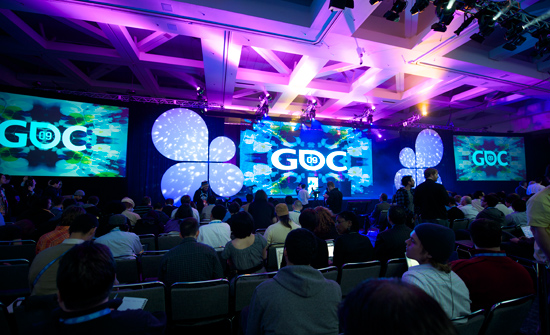
As with all conferences, this one started with a keynote. And not just any keynote. The 2009 Game Developers Conference started with a keynote from the president of Nintendo: Saturo Iwata.
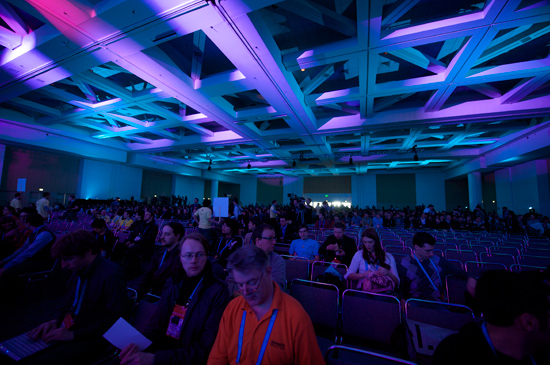
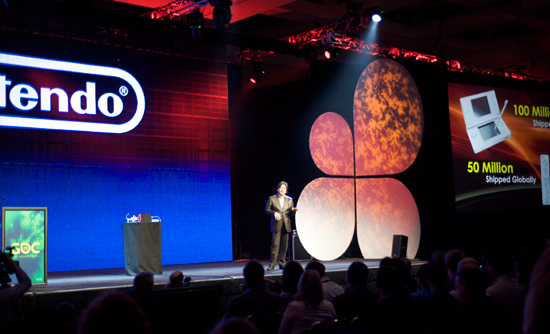
Iwata on stage
I’d never been to a Nintendo keynote before, nor had I ever heard Iwata speak. He spoke with a very mild lisp but was very calm, collected and confident in his delivery. I don’t really know how else to describe it other than that he spoke the way you’d expect the president of Nintendo to speak.
Nintendo has had a huge impact on the video game business in the US and around the world, largely due to the success of the Wii. The Wii is extremely popular, but Iwata really put it in perspective. Nintendo has shipped over 50 million Wii consoles since its launch in 2006. That’s the fastest ramp rate of any console. The Wii Balance Board, the peripheral that comes with Wii Fit, has sold around 15 million units. That in itself is nearly as many units shipped as Sony’s PlayStation 3.

Over 40M consoles shipped by the end of last year. 50 million total since then.
The graph below shows total US video game market growth for an eight year period starting in 2001. The bars represent total video game hardware, software and accessory sales for each year in the US alone.
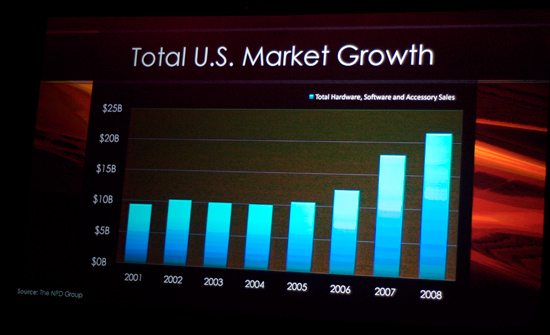
In 2008 the US video game industry broke $20B. That’s pretty impressive. Now look at what percentage of that growth was solely because of Nintendo:
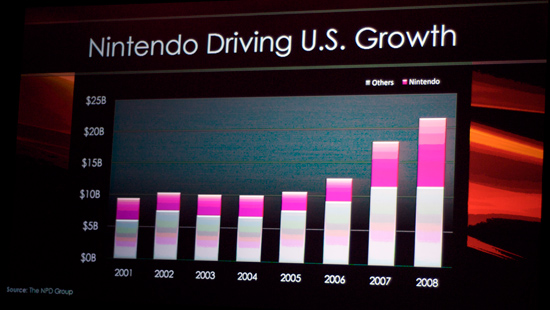
The pink sections of the bars are Nintendo related sales alone
Nintendo accounted for nearly $12B of the $22B US video game industry in 2008. There’s no other way to put it, Nintendo is single handedly driving growth in the US game industry - largely due to the Wii.
The trend is the same in the UK, Germany and France:
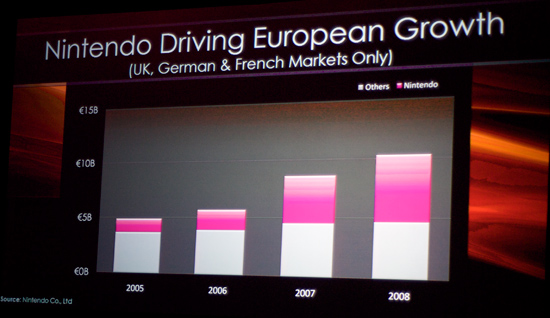
Around half of all video game related sales in those countries last year was because of Nintendo. The numbers are just ridiculous. Cute cuddly video game characters aside, Nintendo is as colossal of a market force as companies like Intel, Microsoft and Google in their respective industries. Nintendo’s size in itself shouldn’t be surprising, but when characterized in terms of the entire video game market it’s shocking.
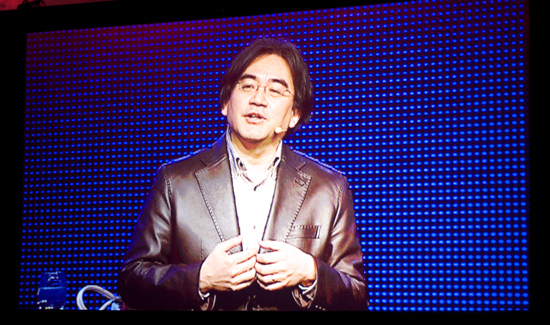
This next part was cool. Iwata took us through how goes about designing games. For those of you who don’t know, Miyamoto is the creator of Mario, Zelda, Pikmin, Nintendogs and some of Nintendo’s other extremely popular franchises. Given that Iwata was speaking to an audience of game developers, choosing to speak about Miyamoto’s approach to game design made a lot of sense. But to me, it was just awesome to hear about how someone who is great at his craft goes about his work. I love stories like that.
Let’s get started.










38 Comments
View All Comments
arturnowp - Friday, March 27, 2009 - link
Resolution is not that big problem. Imagine 720p with 16x AA. There is resolution bound caused by netword bandwidth not because of data center perfomance.MrSAballmer - Thursday, March 26, 2009 - link
Interesting stuff here, especially the fishnet-girls!http://fakesteveballmer.blogspot.com">http://fakesteveballmer.blogspot.com
spuddyt - Thursday, March 26, 2009 - link
I mean, a fat red plumber jumping on mushrooms....drwheel - Thursday, March 26, 2009 - link
That's how the article reads anyway.It amazes me that bigfoot networks is still in business. Another killer nic product that delivers marginal improvements that are rivalled by a $25 intel card:
http://forum.ncix.com/forums/topic.php?id=1304406">http://forum.ncix.com/forums/topic.php?id=1304406
And a streaming video game system! Awesome. Seeing as how gamers like myself already complain about latency on lcd monitors that claim to have single-digit ms response times (not always true), or who can easily notice a different between at 20ms versus a 100ms ping time to a game server, I'm sure throwing another 80ms of lag in there because your game is being pre-rendered elsewhere won't hurt either! Haha.
What a joke. Is this the best stuff there is to report about at GDC?
SSDMaster - Thursday, March 26, 2009 - link
They've really done something unique with onLive though... you gotta hand it to them.They've created a new type of lag.
Before you just had to wait till the server showed you where your enemies were, but NOW you get to wait to see your character turn every time you hit the control stick...
GENIUS!
drwheel - Thursday, March 26, 2009 - link
And let's not forget the other issues with this platform aside from latency. This company better have a ginormous data center with tons of mid to high-end systems, each one with a dedicated gfx card for each player, and gobs and gobs of bandwidth on a very reliable backbone. We're talking about AIG bailout money here.This entire venture just sounds like something that will never get off the ground. And even if it does, there is a list of logistical issues that will cause it to fail. Sorry, but this sounds like the next "Sega Channel" or better yet... Phantom game console.
Good idea, but there is no way it will ever work. Atleast, not until this country's network infrastructure is improved to a point where coast-to-coast latency is in the single-digit millisecond range, and everyone has atleast 10Mbps bandwidth in their home (read: not for at least another 10 years).
bespoke - Thursday, March 26, 2009 - link
"And let's not forget the other issues with this platform aside from latency. This company better have a ginormous data center with tons of mid to high-end systems, each one with a dedicated gfx card for each player, and gobs and gobs of bandwidth on a very reliable backbone. We're talking about AIG bailout money here."Right - this is the point I don't understand. We've got to be talking about quite huge hardware investment per user to run these things. Maybe $500 of hardware per user? Are these guys really going to spend that much money up front? Are they going to be able to recoop that money? Will they upgrade hardware every 6-12 months to stay up with games?
baba264 - Thursday, March 26, 2009 - link
I believe I may be able to offer some insight on this question. In my opinion you forget three major facts.The first one is that the game resolution offered are calibrated for the tv. Either standard 800x600 tv, or 1024*720 HD tv, but either way, compared to the kind of resolution we're talking about in a high end gaming rigg, this is very low.
The second fact is that they're probably not going to be running their games on indivdual pc, but rather on a cluster of workstations with high end graphic cards and maybe dedicated hardware for physics rendering. Considering the resolutions involved, one may be able to run quite a few instances of a game on a single machine.
The third is that, given the resolutions offered and the latency issues, this seems to me like a product aimed much more at the console crowd and maybe the notebook crowd than at the pc gaming one.
To sum it up there must be some large input of money to start up the thing, but if it's well designed, one may be able to add to load capacity without changing the architecture, just by plugging in new machines. So the initial investment is just a few machines and all the design and software to run the thing. Furthermore, one does get some economy through scaling so the number are not as bad as they seem. And since it's aimed mostly at the console crowd, that's more used to latency, the add up might not be an issue in most games.
So all in all, seen as something to replace your console (and not your pc) or to get into gaming if you don't have any hardware yet, this seems like a fairly good idea to me. However, I am concerned, as others have expressed before me, with the impact this traffic will have on Internet as a whole if this service becomes popular.
araczynski - Thursday, March 26, 2009 - link
i'm really hoping onlive gets traction, it would catch the industry off guard at the least, but i'd think for the most part the developers would love it.great way to fight piracy and gamestop, not to mention opening up a whole new potential userbase for developers to sell to, i.e. those that don't want to waste time/money on buying/building crazy gaming rigs.
the 720p limitation at the moment does worry me a bit, but then again that's probably not that big of an issue when the device is hooked up to say a laptop screen, as opposed to a tv/monitor.
in any case, broadband speeds are only increasing, even in the backwater US, so full 1080p shouldn't be all that far off.
The0ne - Thursday, March 26, 2009 - link
Speed increase with download/upload caps. Yea, good combo alright.